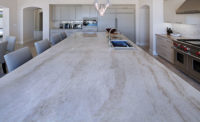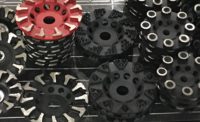During my travels to major slab producers in places such as Brazil and Italy, it seems that there are more exotics on the market than ever before. The general consensus among suppliers and buyers was that by investing in exotics, companies will be able to separate themselves from the competition, and they are less likely to be beaten down on the basis of price.
Do today's fabricators agree with this theory? How much are fabricators working with exotic materials now as compared to the last year or two years? Are people willing to pay the extra money for these materials, or are they still trying to save a few bucks per foot?
As a fabricator, how difficult is it to work with exotics? Is the financial return generally worth it?
I asked these questions to a group of fabricators from the Stone Fabricators Alliance, and here are their responses:
Dan Riccolo, Morris Granite, Morris, IL: Exotics are certainly a good share of the product mix these days and growing. Along with the higher price and fragility, there is also the fact that it takes more raw footage to make a job look good by seam matching the grain. This means more waste, thus even higher costs. The key is to understand your costs and charge accordingly. The exotics sell themselves, but they can mean losing money on a job gone bad.
Joey Marcella, Mario & Son, Inc., Liberty Lake, WA: We stock a large amount of slabs in our warehouse. Exotic stone comprises about 50% of the overall product mix we carry. People seem to want something new that they have not seen in a big-box store.
For the fabricator, working with exotic stone can be tricky. Grain matching becomes more critical, which usually translates into more waste. Many of these materials are often very fragile, which adds to the fabrication timeline. Some materials, as beautiful as they are, contain more surface traits that homeowners may find objectionable. These same consumers generally believe that the higher cost of the stone, the higher the overall quality of the raw material. This is rarely the case.
For us, the key to working with exotics is to make sure to bring in ample stock. That way, we can recycle the matching remnants back into the future jobs more economically, thus offsetting the higher waste factors. This is not possible if you only bring in enough slabs for each individual project.
Dustin Braudway, Bluewater Surfaces, Wilmington, NC: Having a good mix of exotic stones and "staple" stones is great for any fabricator's yard. That said, when bringing in exotics, you need to look at your historical exotic colors that tend to sell in your area. A fabricator does not want to be bringing exotics that won't sell in their market. When starting out with exotics, get a container of the historical sellers, and then throw in a bundle or two of some new exotics for your market.
When importing and selling exotics or staples, your sales force needs to be able to move these materials. You don't want a bunch of coin sitting out in inventory with nobody buying it. Introduce a new color here and there, and build your selection. There is also a mindset right now in the industry that bringing in cheaper commercial-grade material exotics is a good practice; thinking that a fabricator can sell at the same price or just a bit above staple colors, such as a Group Two color range. They feel this gives them a little more leverage over their competition. It will if the customer is looking for an exotic, but nine times out of 10, if they want the Ubatuba look, they want what they want. So importing cheap exotics to sell against Ubatuba is, in my opinion, silly and a good way to devalue the price of the exotic market.
Right now, I would say that in this market we are seeing a good mix of exotic-to-staple ratio. We get paid more for exotics because typically the material costs more; the stone can be sometimes harder to work with and handle; the grain match must be taken into account more; and layout is the most important. With exotics, your yield is less because professional companies and craftsman understand that grain flow and color match is the most important thing. This should also always be explained to the customer, and they should in return buy enough material to make this happen.
Does it always work out like this? Unfortunately, the answer is "no." Does working with exotics make the risk versus reward worth it? I think so. Not only do I charge accordingly, but I also get a warm fuzzy feeling when we make killer, tricked-out vein layouts match up, and it looks like a piece of art.
Mike Dean, The Top Shop Inc., London, Ontario, Canada: Exotics set you apart from the local competition. Having something for your customer that their neighbor doesn't have makes them sign the contract right there. We've moved to more exotics in the past two years, and we kept our existing stock of staple colors the same. Our number one and number two sellers last year were exotics. The trick is volume. Get as much of one block as you can to save on the waste. This is a simple concept, but remember that there is much more waste with grained exotics. Also, ensure the customer is educated on the fact that if you must seam, you are putting two pieces of nature together.
Kevin Padden, AZ School of Rock, Sun Tan Valley, AZ: The location of a given fabricator will also have an impact on how much of the exotic slab market he will be involved in. In my opinion, the four "black holes" in the U.S. are Southern California, Las Vegas, Arizona and South Florida -- the exact opposite of five years ago. I am in Arizona, and I can tell you that the exotic market here -- although alive -- is not anywhere near what it is in other parts of the U.S. I know that Arizona Tile has done a tremendous job promoting exotics here in Arizona, and through their efforts, they are creating a "niche" market segment for fabricators that have the skills to work with exotics. This is true not only here, but in other parts of the country as well.
Guys that do have the opportunity to work with the exotic slabs had better keep track of every dimension and detail of the job from start to finish. As others have said, any mistake you make or allow to happen is amplified 10 times over due to the enormous cost of the slab -- and the potential for replacing it -- if somebody in your production chain mis-measures or mis-cuts and gives you cause not only for buying a replacement slab, but also introducing the offending employee to the wonderful world of "entering the new job search" arena.
If you have confidence in your staff -- and your local market will bear it -- working with exotics is definitely a part of our industry that you as a fabricator need to consider. Just remember that while "the view can be really great up there," you are still on the tightrope until the job is done and paid for.




.jpg?height=200&t=1725444349&width=200)


